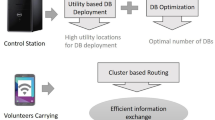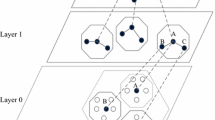Abstract
In this paper, we propose a data aggregation back pressure routing (DABPR) scheme, which aims to simultaneously aggregate overlapping routes for efficient data transmission and prolong the lifetime of the network. The DABPR routing algorithm is structured into five phases in which event data is sent from the event areas to the sink nodes. These include cluster-head selection, maximization of event detection reliability, data aggregation, scheduling, and route selection with multi attributes decision making metrics phases. The scheme performs data aggregation on redundant data at relay nodes in order to decrease both the size and rate of message exchanges to minimize communication overhead and energy consumption. The proposed scheme is assessed in terms of packet delivery, network lifetime, ratio, energy consumption, and throughput, and compared with two other well-known protocols, namely “information-fusion-based role assignment (InFRA)” and “data routing for in-network aggregation (DRINA)”, which intrinsically are cluster and tree-based routing schemes designed to improve data aggregation efficiency by maximizing the overlapping routes. Meticulous analysis of the simulated data showed that DABPR achieved overall superior proficiency and more reliable performance in all the evaluated performance metrics, above the others. The proposed DABPR routing scheme outperformed its counterparts in the average energy consumption metric by 64.78% and 51.41%, packet delivery ratio by 28.76% and 16.89% and network lifetime by 42.72% and 20.76% compared with InFRA and DRINA, respectively.
















Similar content being viewed by others
References
Gupta, L., Jain, R., & Vaszkun, G. (2016). Survey of important issues in UAV communication networks. IEEE Communications Surveys & Tutorials,18, 1123–1152.
Amiri, I. S., Ariannejad, M., Jalil, M., Ali, J., & Yupapin, P. (2018). Modeling optical transmissivity of graphene grate in on-chip silicon photonic device. Results in Physics,9, 1044–1049.
Ray, P. P., Mukherjee, M., & Shu, L. (2017). Internet of things for disaster management: state-of-the-art and prospects. IEEE Access,5, 18818–18835.
Ray, N. K., & Turuk, A. K. (2017). A framework for post-disaster communication using wireless ad hoc networks. Integration,58, 274–285.
Lu, R., Heung, K., Lashkari, A. H., & Ghorbani, A. A. (2017). A lightweight privacy-preserving data aggregation scheme for fog computing-enhanced IoT. IEEE Access,5, 3302–3312.
Rajagopalan, R., & Varshney, P. K. (2006). Data-aggregation techniques in sensor networks: A survey. IEEE Communications Surveys & Tutorials,8, 48–63.
Jiang, H., Jin, S., & Wang, C. (2010). Parameter-based data aggregation for statistical information extraction in wireless sensor networks. IEEE Transactions on Vehicular Technology,59, 3992–4001.
Bruzgiene, R., Narbutaite, L. & Adomkus, T. (2017). MANET network in internet of things system. Ad Hoc Networks. https://doi.org/10.5772/66408
Tilwari, V., Dimyati, K., Hindia, M. H. D., Fattouh, A., & Amiri, I. S. (2019). Mobility, residual energy, and link quality aware multipath routing in MANETs with Q-learning algorithm. Applied Sciences,9, 1582.
Ladas, A., Deepak, G. C., Pavlatos, N., & Politis, C. (2018). A selective multipath routing protocol for ubiquitous networks. Ad Hoc Networks,77, 95–107.
Gachhadar, A., Hindia, M. N., Qamar, F., Siddiqui, M. H. S., Noordin, K. A., & Amiri, I. S. (2018). Modified genetic algorithm based power allocation scheme for amplify-and-forward cooperative relay network. Computers & Electrical Engineering,69, 628–641.
Hindia, M. N., Qamar, F., Rahman, T. A., & Amiri, I. S. (2018). A stochastic geometrical approach for full-duplex MIMO relaying model of high-density network. Ad Hoc Networks,74, 34–46.
Barcelo, M., Correa, A., Llorca, J., Tulino, A. M., Vicario, J. L., & Morell, A. (2016). IoT-cloud service optimization in next generation smart environments. IEEE Journal on Selected Areas in Communications,34, 4077–4090.
Udaiyakumar, R., Joseph, S., Sundararajan, T., Vigneswaran, D., Maheswar, R., & Amiri, I. S. (2018). Self clock-gating scheme for low power basic logic element architecture. Wireless Personal Communications,102, 3477–3488.
Heinzelman, W. B., Chandrakasan, A. P., & Balakrishnan, H. (2002). An application-specific protocol architecture for wireless microsensor networks. IEEE Transactions on Wireless Communications,1, 660–670.
Dasgupta, K., Kalpakis, K., & Namjoshi, P. (2003). An efficient clustering-based heuristic for data gathering and aggregation in sensor networks. In IEEE Wireless Communications and Networking, WCNC 2003 (pp. 1948–1953). IEEE.
Zarei, B., Zeynali, M., & Nezhad, V. M. (2010). Novel cluster based routing protocol in wireless sensor networks. International Journal of Computer Science Issues (IJCSI),7, 32.
Rajeswari, K., & Neduncheliyan, S. (2017). Genetic algorithm based fault tolerant clustering in wireless sensor network. IET Communications,11, 1927–1932.
Engel, A., & Koch, A. (2016). Heterogeneous wireless sensor nodes that target the internet of things. IEEE Micro,36, 8–15.
Li, J., Deshpande, A. & Khuller, S. (2010). On computing compression trees for data collection in wireless sensor networks. In Proceedings IEEE INFOCOM (pp. 1–9). IEEE.
Krishnamachari, L., Estrin, D. & Wicker, S. (2002). The impact of data aggregation in wireless sensor networks. In Proceedings 22nd international conference on distributed computing systems workshops (pp. 575–578).
Lee, M. & Wong, V. W. S. (2005). An energy-aware spanning tree algorithm for data aggregation in wireless sensor networks, In PACRIM. 2005 IEEE pacific rim conference on communications, computers and signal processing (pp. 300–303). IEEE.
Eskandari, Z., Yaghmaee, M. H. & Mohajerzadeh, A. (2008). Energy efficient spanning tree for data aggregation in wireless sensor networks. In Proceedings of 17th international conference on computer communications and networks (pp. 1–5). IEEE.
Cheng, C.-T., Leung, H., & Maupin, P. (2013). A delay-aware network structure for wireless sensor networks with in-network data fusion. IEEE Sensors Journal,13, 1622–1631.
Cristescu, R., Beferull-Lozano, B., Vetterli, M., & Wattenhofer, R. (2006). Network correlated data gathering with explicit communication: NP-completeness and algorithms. IEEE/ACM Transactions on Networking (ToN),14, 41–54.
Nakamura, E. F., Oliveira, H. A. B. F. D., Pontello, L. F. & Loureiro, A. A. F. (2006). On demand role assignment for event-detection in sensor networks. In 11th IEEE symposium on computers and communications (ISCC’06), pp. 941–947.
Villas, L. A., Boukerche, A., Ramos, H. S., de Oliveira, H. A. B. F., de Araujo, R. B., & Loureiro, A. A. F. (2013). DRINA: A lightweight and reliable routing approach for in-network aggregation in wireless sensor networks. IEEE Transactions on Computers,62, 676–689.
Yan, Y., Zhang, B., Zheng, J., & Ma, J. (2010). Core: a coding-aware opportunistic routing mechanism for wireless mesh networks [accepted from open call]. IEEE Wireless Communications,17, 96–103.
Cheng, H., & Jia, X. (2005). An energy efficient routing algorithm for wireless sensor networks. In Proceedings. 2005 international conference on wireless communications, networking and mobile computing (pp. 905–910). IEEE.
Bouabdallah, F., Bouabdallah, N., & Boutaba, R. (2013). Efficient reporting node selection-based MAC protocol for wireless sensor networks. Wireless Networks,19, 373–391.
Osamy, W., Khedr, A. M., Aziz, A., & El-Sawy, A. A. (2018). Cluster-tree routing based entropy scheme for data gathering in wireless sensor networks. IEEE Access,6, 77372–77387.
Li, X., Liu, W., Xie, M., Liu, A., Zhao, M., Xiong, N., et al. (2018). Differentiated data aggregation routing scheme for energy conserving and delay sensitive wireless sensor networks. Sensors,18, 2349.
Zheng, H., Yang, F., Tian, X., Gan, X., Wang, X., & Xiao, S. (2015). Data gathering with compressive sensing in wireless sensor networks: A random walk based approach. IEEE Transactions on Parallel and Distributed Systems,26, 35–44.
Luo, D., Zhu, X., Wu, X. & Chen, G. Maximizing lifetime for the shortest path aggregation tree in wireless sensor networks, pp. 1566–1574.
Xiang, L., Luo, J., & Rosenberg, C. (2013). Compressed data aggregation: Energy-efficient and high-fidelity data collection. IEEE/ACM Transactions on Networking (TON),21, 1722–1735.
Zhou, F., Chen, Z., Guo, S., & Li, J. (2016). Maximizing lifetime of data-gathering trees with different aggregation modes in WSNs. IEEE Sensors Journal,16, 8167–8177.
Sengupta, S., Rayanchu, S., & Banerjee, S. (2010). Network coding-aware routing in wireless networks. IEEE/ACM Transactions on Networking (TON),18, 1158–1170.
Le, J., Lui, J. C. S., & Chiu, D.-M. (2010). DCAR: Distributed coding-aware routing in wireless networks. IEEE Transactions on Mobile Computing,9, 596–608.
Kouhdaragh, V., Amiri, I. S., & Seyedi, S. (2017). Smart grid load balancing methods to make an efficient heterogeneous network by using the communication cost function. IET Networks,7, 95–102.
Ying, L., Shakkottai, S., Reddy, A., & Liu, S. (2011). On combining shortest-path and back-pressure routing over multihop wireless networks. IEEE/ACM Transactions on Networking (TON),19, 841–854.
Sasirekha, S., & Swamynathan, S. (2017). Cluster-chain mobile agent routing algorithm for efficient data aggregation in wireless sensor network. Journal of Communications and Networks,19, 392–401.
Udaiyakumar, R., Joseph, S., Sundararajan, T., Vigneswaran, D., Maheswar, R., & Amiri, I. S. (2018). Performance analysis in digital circuits for process corner variations, slew-rate and load capacitance. Wireless Personal Communications,103, 99–115.
Biswas, P. K., Qi, H., & Xu, Y. (2008). Mobile-agent-based collaborative sensor fusion. Information Fusion,9, 399–411.
De Couto, D. S. J., Aguayo, D., Bicket, J., & Morris, R. (2005). A high-throughput path metric for multi-hop wireless routing. Wireless Networks,11, 419–434.
Tran, A. T., Mai, D. D., & Kim, M. K. (2015). Link quality estimation in static wireless networks with high traffic load. Journal of Communications and Networks,17, 370–383.
Rhee, I., Shin, M., Hong, S., Lee, K., Kim, S. J., & Chong, S. (2011). On the levy-walk nature of human mobility. IEEE/ACM Transactions on Networking,19, 630–643.
Huang, H., Yin, H., Min, G., Zhang, J., Wu, Y., & Zhang, X. (2018). Energy-aware dual-path geographic routing to bypass routing holes in wireless sensor networks. IEEE Transactions on Mobile Computing,17, 1339–1352.
Acknowledgements
The authors would like to acknowledge EPSRC Grant EP/P028764/1 (UM IF035-2017).
Author information
Authors and Affiliations
Corresponding author
Ethics declarations
Conflict of interest
The authors declare that there is no conflict of interest regarding the publication of this paper.
Additional information
Publisher's Note
Springer Nature remains neutral with regard to jurisdictional claims in published maps and institutional affiliations.
Rights and permissions
About this article
Cite this article
Amiri, I.S., Prakash, J., Balasaraswathi, M. et al. DABPR: a large-scale internet of things-based data aggregation back pressure routing for disaster management. Wireless Netw 26, 2353–2374 (2020). https://doi.org/10.1007/s11276-019-02122-3
Published:
Issue Date:
DOI: https://doi.org/10.1007/s11276-019-02122-3




